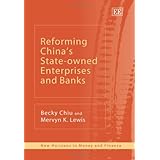
Average Reviews:

(More customer reviews)Are you looking to buy REFORMING CHINA'S STATE-OWNED ENTERPRISES AND BANKS (New Horizons in Money and Finance)? Here is the right place to find the great deals. we can offer discounts of up to 90% on REFORMING CHINA'S STATE-OWNED ENTERPRISES AND BANKS (New Horizons in Money and Finance). Check out the link below:
>> Click Here to See Compare Prices and Get the Best Offers
REFORMING CHINA'S STATE-OWNED ENTERPRISES AND BANKS (New Horizons in Money and Finance) ReviewThe shares of GDP, employment, and output attributable to SOEs, collectives, TVEs, or hybrids are difficult to determine because of China's confusing ownership issues - eg. many 'private' firms are actually owned by the state, with only a minority-share traded. All significant enterprises are headed by CEOs approved by the CCP, and they also have a Party Committee headed by a Secretary who is equal in rank to the CEO.When the CCP took power in 1949, its main objective was to rapidly industrialize. Its transition beginning in 1978 was accomplished without privatization, secure property rights, and without democracy.(Property rights are less restricted than one might think.) China's transition also violated conventional wisdom on speed - China's was gradual, not a 'big bang' aka Russia. TVEs originated in 1958 with the Great Leap Forward - small-scale industrial enterprises (eg. backyard steel mills) set up by communes (all failed). The later re-emerged as agricultural and machine repair shops, food processing mills, and SOE sub-contractors. Their growth was unexpected. Between 1979-93, most new firms were TVEs.
China's initial transition also created 4 SEZs - this grew to 117 by 1991, 1,700 in 1992. Tax exemptions were given for five years, then lower taxes than normal. Dual-track pricing allowed liberalizing markets without creating losers and encouraged efficiency gains. In 1992, after Deng's high-profile tour of the south, the CCP endorsed the 'socialist market economy' as its reform goal; at that point it also implemented uniform tax rates and Western accounting.
Ninety-percent of SOEs are administered by local governments. Many of the oldest had their genesis in 156 aid projects from Russia during 1952-56; some date back to Japanese occupation. SOE factories were mini-towns. Providing these cradle-grave services were the reason for the SOE. China intends to maintain pillar industries in high-technology, non-renewable resources, public utility, and infrastructure services - sectors seen as vital to its national security. SOE reforms now allow bankruptcy, liquidation, auctions, debt for equity swaps, and mass layoffs. Between 1995-99m state-sector employment fell 27 million, and the non-state sector employment rose 50 million. SOBs were increasingly responsible for their losses/bad debts and had less required obligation to fund SOEs.
Most listed firms do not have employee shares, and management owns none or very few shares of those firms. Thus, they lack the personal incentives prevalent in the U.S.Star Computer pays management bonuses 10 years later. As of 1/05, there were 1,377 listed companies on Chinese exchanges. Very few are non-state - most are transformed SOEs. The number listed from each province is limited. Only about one-third of SOE capital is listed. Haier is 30% government -owned - it began as a collective in the 1980s. China Mobile is 75% owned by China Mobile Communications Corporation (100% state-owned). Most capital raising by Chinese enterprises via bank loans - 83% in 2004; corporate bonds and equity new issue accounted for 6%. SOEs receive 3/4th of SOB short-term loans, 60% of medium-to-long term loans. Private businesses initial capital is 91% self-financing. Half of FDI during the 1990s came from Hong Kong, Singapore, and Taiwan, and much of that was mainland money to start with. ("Round-trip" to obtain better government treatment.) In 2004, only about 2% of bank assets within China were foreign-owned, and they only had 1% market share.
Clustering auto parts manufacturing near Shanghai makes SAIC monitoring and improving easier (eg. VW established a nearby test lab, and hired several retired engineers).
National savings in 1978 were relatively high - government (15% GDP), enterprise (17% GDP), and households (1% GDP). From 1995-2004, labor costs increased 3X, productivity > 5X --> overall labor cost decline of 43%.REFORMING CHINA'S STATE-OWNED ENTERPRISES AND BANKS (New Horizons in Money and Finance) Overview
Want to learn more information about REFORMING CHINA'S STATE-OWNED ENTERPRISES AND BANKS (New Horizons in Money and Finance)?
>> Click Here to See All Customer Reviews & Ratings Now
0 comments:
Post a Comment